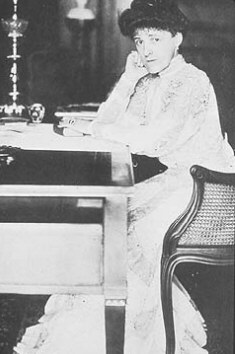Body image
During the 1920s, media platforms such as advertisements and film began to surface with the goal of popularizing this new idea of the perfect female body. With the trending use of cosmetics, as well as cosmetic surgery, becoming more available during this time, women, in particular, pounced on the idea of altering their bodies accordingly to fit in with these standards. [11] Edith Wharton's 1927 novel Twilight Sleep, reflects these similar trends in a number of ways.
The novel essentially has three main female protagonists, and readers follow their daily lives throughout the novel. These main characters being Pauline, Lita and Nona. Each of these female characters has a different relationship with their body, and each has taken on a different literary role concerning 1920s technology of the female body. Beginning with Pauline, she has used new technological advances of the time, in order to work on tailoring her body to the 1920s idea of perfection. From the very beginning of the novel we see how Pauline Manford has an extremely busy schedule, full of techniques that she believes will alter her body and mind. [12] As she makes her many attempts at rejuvenating her body, she often forgets about her own children and has very little time for them as a result. In addition to this Pauline's body is constantly on the move, making her one of the most efficient characters in this sense. Her body is consistently at work and goes from either running her home to achieving her many public duties outside of the home. As a female character set in the 1920s, Pauline spends a huge amount of time working and improving on her body and image.
On the other hand, Lita is the character within the novel who serves as the overall image of these new beauty standards. While this does come with a downfall as well, as the women in Lita's life try to prevent her body from being used to attract men. For example, Nona follows Lita to multiple parties with the idea of keeping an eye on her. While Pauline attempts to talk Lita out of getting involved in movies and dancing, and instead pushes her towards focusing on being a housewife. Whereas Nona undergoes the pain of always comparing herself to Lita, and feeling as though she is hidden behind Lita's shadow. Although at the end of the novel, this is the same body that saves her family, as she essentially takes a bullet for them. [13] Unlike her mother, Nona remains skeptical of these new technologies used on women's exterior, and is the character who ends up staying most true to herself.
Marriage, relationships, and divorce
The most prominent theme in Twilight Sleep is the dysfunctional relationships that the characters have with one another. This is especially significant in terms of romantic relationships, marriage, and divorce. In the 1920s, marriage was a key life goal for women, but divorce was becoming more acceptable and the number of divorced couples was on the rise. This cultural shift is what Wharton chooses to focus on in Twilight Sleep. Through her characters, Wharton seemingly asserts that these breakdowns in relationships are tied to a lack of communication and sense of identity within the characters. All of the characters in this novel struggle to understand themselves and this makes it nearly impossible for them to understand each other. [2] This lack of communication and moments of misunderstanding can be most clearly seen with Pauline and her interactions with others, especially with her husband Dexter. During a dinner party she feels that she's done something special for Dexter when she sets him next to Mrs. Toy, believing that Dexter gains pleasure from flirting with her. In reality Dexter has no social interest in Mrs. Toy and it isn't until later that he has a purely sexual interest and has an affair with her.
Wharton's characters are a display of the modern personalities of the 1920s, personalities that are often dull, shallow, and selfish. The characters' need for a stronger sense of self identity leads them to be selfish and hold no loyalties to those they have relationships with Lita is a perfect example of this as she becomes increasingly bored with her life and her relationships. [2] She wants more for herself and continuing to be married to Jim does not fit into the identity she is seeking for herself.
The characters' inability to communicate and self-identify are key factors in the breakdown of their relationships and the divorce/want for a divorce that result. Twilight Sleep shows the shift in the cultural perception of marriage from a symbol of wholeness and personal completion to that of a burden on one's self-identity. [2]

